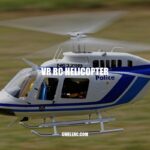P47 RC Plane: A Comprehensive Guide for Aviation Enthusiasts
The P47 Thunderbolt was a World War II fighter aircraft that served primarily in the European theater. This sturdy and heavily armed plane was instrumental in achieving air superiority over the skies of Europe. Today, aviation enthusiasts can enjoy building and flying their own P47 RC planes. This hobby has gained widespread popularity among model airplane enthusiasts all over the world. The P47 RC plane is a perfect hobby for those who love aviation as it offers an opportunity to experience the thrill of flying a historically significant aircraft. In this article, we will discuss the different aspects of the P47 RC plane, including its history, types and models available, building and assembly instructions, maintenance tips, and safety precautions.
Types of P47 RC Planes Available in the Market
- There are different types of P47 RC planes available in the market for enthusiasts.
- Ready-to-fly (RTF) P47 RC planes come pre-built and are easy to use, making them the best choice for beginners.
- Bind-and-Fly (BNF) P47 RC planes require you to bind it with a compatible controller before flying.
- Plug-and-Play (PNP) P47 RC planes require additional parts like a receiver, servos, and a battery to be purchased separately, which makes them great for customization.
- Some of the popular P47 RC planes include FMS P47 Razorback, Top RC P47 Thunderbolt, H-King P-47, and Dynam P-47D Thunderbolt.
What are some popular models of P47 RC planes available in the market?
Some popular models of P47 RC planes available in the market are: E-flite P-47 Razorback, FMS P-47 Thunderbolt, and Dynam P-47D Thunderbolt.
Building and Assembling Your P47 RC Plane
- Before beginning, make sure you have all the necessary tools and equipment. You’ll need a Phillips screwdriver, pliers, a hobby knife, and a soldering iron if your model requires soldering.
- It’s recommended to read the instruction manual thoroughly before starting the assembly process.
- The assembly process includes attaching the landing gear, wings, tail feathers, and installing the electronic components such as a receiver and a motor.
- Here is a sample table with some of the essential parts and their placement:
Part Name Placement Receiver Inside the fuselage Motor Mounted on the firewall Wing Struts Connected from the wings to the fuselage - Once the assembly process is complete, give your P47 RC plane a final check before the maiden flight.
What electronic components are needed to assemble a P47 RC plane?
Some of the electronic components that are needed to assemble a P47 RC plane include a radio transmitter and receiver, servos, ESC (Electronic Speed Controller), motor, battery pack, and propeller.
Flying Your P47 RC Plane
- Before the flight, make sure the batteries are charged, the control surfaces are functioning correctly, and the transmitter settings are accurate.
- Takeoff should be towards the wind direction, and the pilot should maintain the P47 RC plane’s balance during takeoff and landing.
- Practice basic maneuvers such as turning, ascending and descending, and figure 8’s until you become more comfortable with flying.
- During the flight, keep an eye on the battery life and control the altitude and speed of the P47 RC plane.
- Be mindful of other people and cars, especially if you are flying in public spaces.
- If you are a beginner, it’s best to practice flying in an open field or a designated flight zone.
- There are several tutorials available on websites such as Horizon Hobby and FliteTest that can help you learn how to fly a P47 RC plane.
What are some tips for beginners when flying a P47 RC plane?
Some tips for beginners when flying a P47 RC plane include starting with a trainer plane, practicing on a simulator, ensuring proper wing loading and balance, performing a pre-flight check, maintaining a safe flying distance, and avoiding flying in windy or turbulent conditions.
Maintenance and Repair of P47 RC Plane
- If you notice any damage to your P47 RC plane, it’s important to address it immediately to prevent further problems.
- Common problems with P47 RC planes include servo malfunctions, propeller damage, and electrical faults.
- Regular cleaning and maintenance of the plane can help prevent problems from occurring.
- Store your P47 RC plane in a dry, cool place and avoid extreme temperatures.
- If you are unsure about how to repair your P47 RC plane, there are numerous online forums and tutorials that can assist you, such as RCGroups and RCU Forums.
- It’s important to only use high-quality replacement parts when repairing your P47 RC plane to ensure its continued safe operation.
- If the problem is extensive, it’s best to take the plane to a specialized repair shop.
What are some common problems with P47 RC planes?
Common problems with P47 RC planes include difficulty in getting the plane to stay in the air, issues with the engine, problems with the landing gear, and difficulties with controlling the plane during flight.
Safety Precautions
- Before flying your P47 RC plane, check to ensure that the area is clear of people and obstacles.
- Make sure that your plane is properly balanced and trimmed before takeoff.
- Stay within a safe distance of the plane while it is flying, and avoid flying near other people or animals.
- Always follow the manufacturer’s instructions and safety guidelines when operating your P47 RC plane.
- Do not fly your P47 RC plane in an area where there are power lines or other obstacles that could interfere with its operation.
- Be cautious of the weather conditions, and avoid flying in windy or stormy conditions that could make it difficult to handle the plane.
- Store the batteries for your P47 RC plane in a safe, dry place away from heat or flame.
What precautions should I take when flying a P47 RC plane?
Some precautions to take when flying a P47 RC plane include ensuring the batteries are fully charged, checking the weather conditions before flying, ensuring the area is clear of people and objects, and being familiar with the controls and capabilities of the aircraft.
Resources and Tips for P47 RC Plane Enthusiasts
P47 RC planes are a fantastic hobby for aviation enthusiasts. They’re easy to build, fun to fly, and offer endless hours of entertainment. If you’re interested in getting started with P47 RC planes, there are a variety of resources available to help you learn more about this exciting hobby.
Firstly, you can find a wealth of information on P47 RC planes by searching online. Many forums and blogs are dedicated to P47 RC planes, where you can find tips and tricks for building and flying your plane. You can also find reviews and recommendations for different types of planes and accessories.
Another great resource for P47 RC plane enthusiasts is your local hobby shop. Hobby shops often carry a wide variety of RC planes and accessories, and the staff can offer valuable advice and guidance on getting started with the hobby.
Additionally, you can learn more about P47 RC planes by attending local events and exhibitions. These events offer a great opportunity to meet other aviation enthusiasts and learn more about the hobby.
In conclusion, P47 RC planes are an exciting hobby that offers endless hours of entertainment. Whether you’re a beginner or an experienced pilot, there are resources available to help you learn more about building, flying, and maintaining your plane. By taking advantage of these resources, you can get the most out of your P47 RC plane and enjoy this exciting hobby to the fullest.



